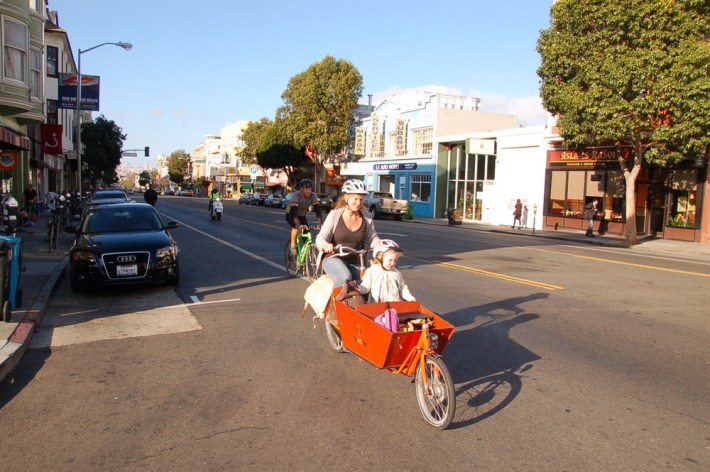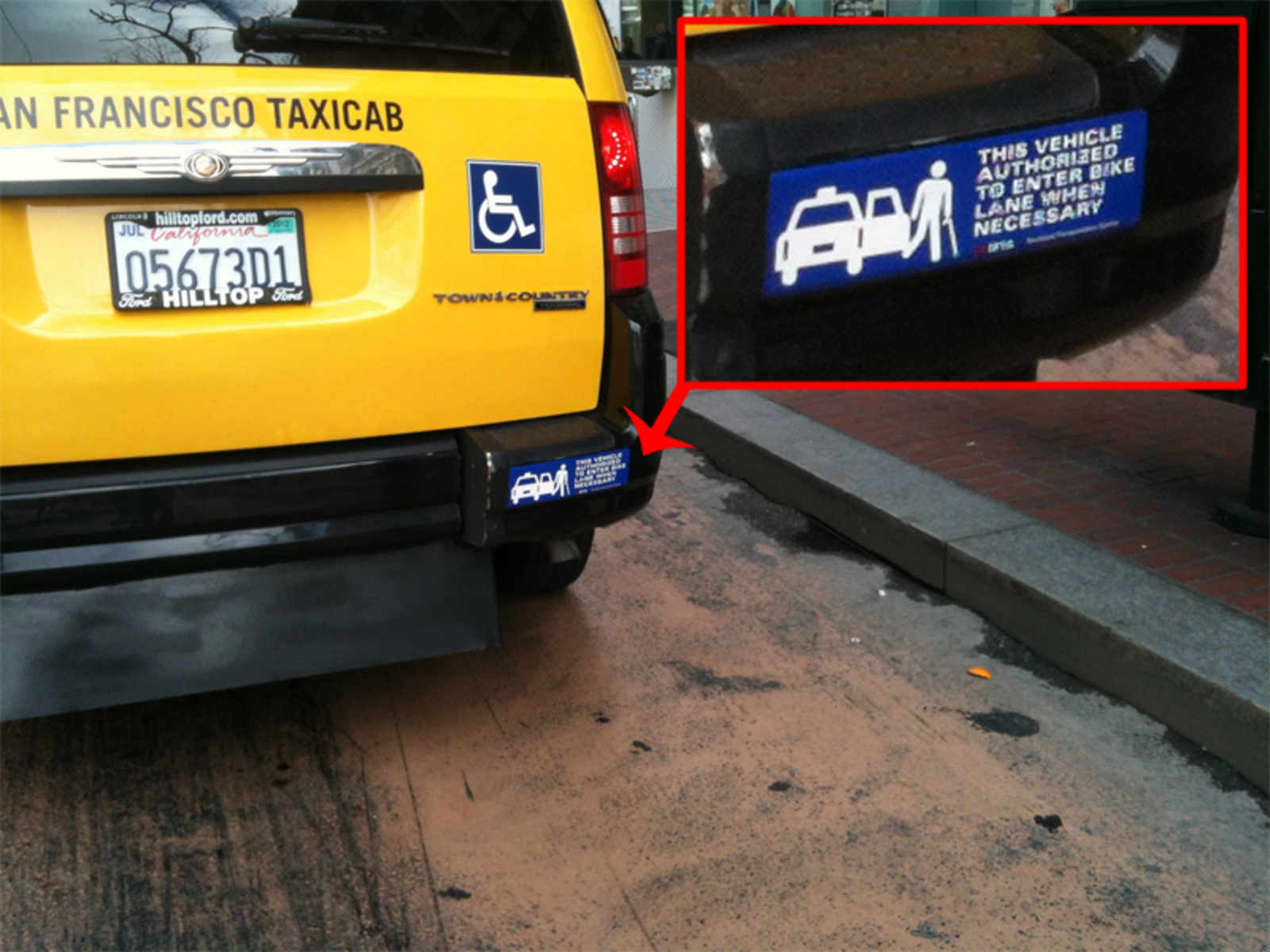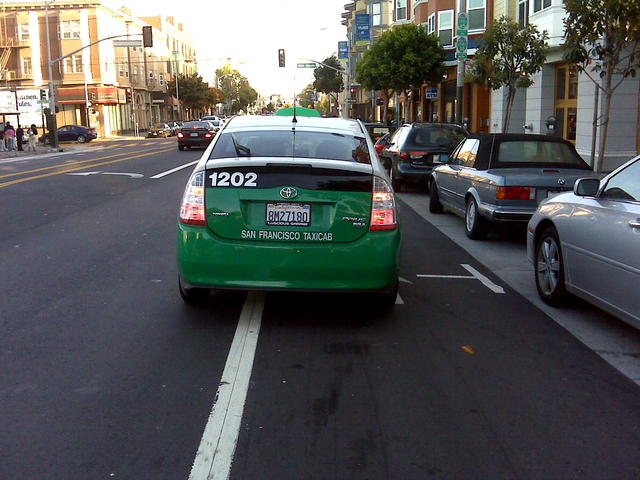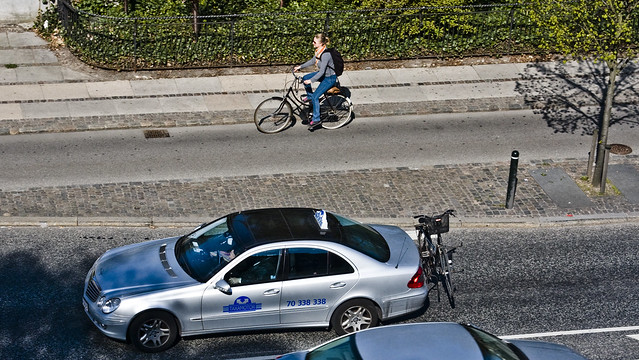I was recently rolling down the 14th Street bike lane when a man standing on the far side of the Guerrero Street intersection flagged down a taxi that had just passed by me. I saw where this was going: The taxi driver stopped next to the bike lane, and the man stepped quickly into it to open the door, without a glance to check for bicycle traffic.
Fortunately, I was prepared to slow my downhill descent and make a safe stop well before running into this man, but not without feeling some fight-or-flight adrenaline. The man and the driver looked at me speechlessly when I said, "Seriously? Have a safe day," before continuing on.
Dangerous and frustrating situations like that are a routine part of using San Francisco's bike lanes. In fact, since the vast majority are striped between parked cars and moving cars, or curbside without protection from traffic, taxis are actually legally allowed -- and instructed -- to stop in the bike lane if there's no better place to pull over.
Marc Caswell, program manager for the SF Bicycle Coalition, teaches a class for the SF Municipal Transportation Agency where taxi driver applicants learn the law and best practices on how to negotiate with bicycles. If no parking spot is available, or it's not practical to pull around the corner, Caswell tells students that loading in the bike lane is the safest and most legal option, compared to directing taxi passengers to step into the bike lane.
"If there is not a bus stop, there is not a fire hydrant, there is not a side street, and the driver does need to pull over and pick up or drop off, say, on a busy corridor even like Valencia Street, [loading in the bike lane] is legal and it is the safest thing to do," said Caswell. He did note, however, that drivers legally "can't stay there, they can't double park there."
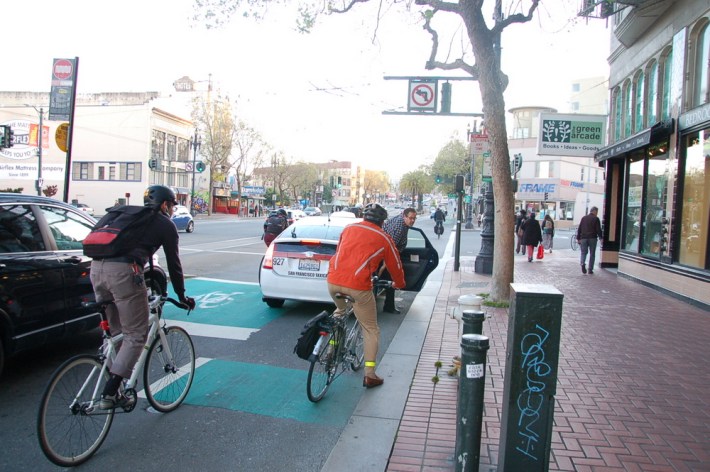
Take a trip down a street like Valencia during business hours, however, and the number of cars shutting down the bike lane makes it readily apparent that "stopping" privileges are widely abused by drivers, taxi or non-taxi. And it's highly questionable whether or not taxis are adhering to the rules laid out on their SFMTA-issued bumper stickers, which feature the figure of a person with a cane leaving a taxi and read, "This vehicle authorized to enter bike lane when necessary."
According to the SFMTA memo [PDF] issued to taxi drivers along with those stickers in October 2011, loading in physically separated bike lanes like those on mid-Market Street should be an "absolutely last resort," and taxis may only enter them to drop off "disabled or elderly customers who require direct access to the curb." Pick-ups are only allowed when the dispatcher tells a driver that “the customer is disabled and must be picked up at a location that is next to a separated bike lane."
While San Franciscans who are intrepid enough to brave the streets on a bike today may be able to handle routinely being forced into lanes with motor traffic, such conditions certainly won't convince families, children, and older San Franciscans to take up biking for transportation.
There are design solutions, however, to safely accommodate taxi loading on busy streets with bike lanes: Raise the bike lanes at or near curb height alongside the sidewalk and include a strip of buffer zone between the bike lane and parked cars for loading and unloading. Such designs are already options in the developing plans for Second and Market Streets, and they would allow car passengers to open doors and access the curb without conflicting with bike traffic. Similar designs have been used on streets in cities like Amsterdam, Copenhagen, and Berlin, which have significantly increased their bicycling rates in recent decades. Chicago is aiming to start implementing raised bike lanes within the next year.
Raised, protected bike lanes sounded like a promising solution to a taxi driver who identified himself only as R.C., whom I interviewed for a separate Streetsblog research assignment in October 2010. R.C., who said he rides a bike and had been driving a taxi in SF for 11 years at the time, liked Market Street's bike lanes, which have posts to separate them motor vehicles.
"I think bike lanes are a good idea, but because I drive a cab, when someone throws a flag up, you’re so hungry, you just turn quick to get that flag," he said. "And if you don’t look before you do that, there’s some guy on a bike that you just cut off."
When asked if he would like to see the Market bike lanes raised to curb height, R.C. said, "That would definitely be better than it is. But that’s gonna cost someone some money."
Athan Rebelos, general manager of DeSoto Cab Company, is more skeptical about whether the design would play out well in San Francisco. Despite having "spent some time" in Copenhagen, he said he thinks Americans are generally just too disobedient of laws and street designs.
"A lot of these things play out really great when you put them on paper, and draw them out," said Rebelos. "I love the idea, but if it's something that's really going to work, I have severe doubts about that, because you're going to have trucks unloading, you're going to have emergency vehicles, and you're still going to have the paratransit problem." (It is worth noting that Copenhagen and Amsterdam certainly haven't shooed all vehicles out of their bike lanes, but calmer streets seem to make the problem less dangerous when it happens.)
In the meantime, Caswell continues to teach 50 taxi applicants at each of his classes, which take place twice a month. SFMTA spokesperson Paul Rose said the agency expects to have 1,200 to 1,500 new taxi drivers on the streets this year.
Rebelos said it's hard to determine how much they're learning compared to those who haven't taken it, since only new taxi drivers are taking the class. He pointed out that to reduce the danger of doorings, companies like DeSoto have installed stickers and mirrors on doors that remind passengers to look for bikes before exiting.
Check out our Streetfilm from last year where American transportation planners visited the Netherlands to look at bikeway designs:
